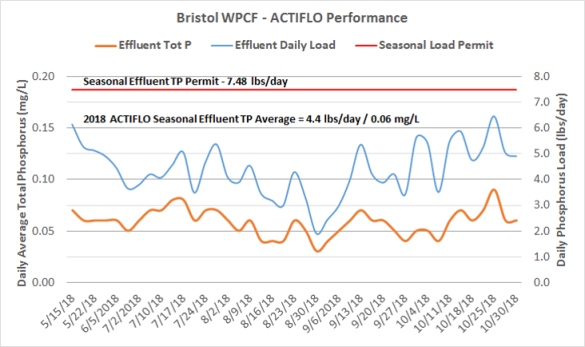The Challenge
The Department of Energy and Environmental Protection issued a nutrient management strategy for freshwater non-tidal streams focusing on seasonal phosphorus limits of 0.1 mg/L per month. The Pequabuck River was identified as one of those streams and a high priority was placed on managing and reducing the nutrient loads and their potential for contributing to water quality impairments.
To meet these new requirements, the City of Bristol set out to reduce phosphorus effluent loads from their Water Pollution Control Facility (WPCF) into the Pequabuck River. Given the high level of phosphorus removal needed, ballasted clarification was the chosen technology and four manufacturer’s were considered and evaluated. The evaluation took into consideration a number of factors including the ability to fit within a limited site footprint, process experience in low effluent phosphorus applications, ease of maintenance and operation, as well as installation and operating costs. The successful manufacturer also had to prove performance through onsite pilot testing.
The Solution
The City of Bristol employed a proven ballasted clarification process with Veolia’s high-rate ACTIFLO® clarifier to meet the treatment performance limit of 0.1 mg/L. The ACTIFLO® process, in tertiary wastewater treatment applications, has proven to effectively treat secondary effluent to reduce TSS and phosphorus removal to meet and exceed the required regulatory guidelines. ACTIFLO® provided the City of Bristol with a proven and reliable system that afforded them the smallest footprint and lowest overall net present value over 20-years of operation compared to all other ballasted clarification technologies. This facility upgrade also included new chemical feed and ultraviolet disinfection systems.
Process Description
he ACTIFLO® high-rate clarification system has been in operation at Bristol’s WPCF since October of 2017. ACTIFLO® is a compact clarification system that utilizes the combination of coagulation, flocculation and sedimentation using microsand as a seed for floc formation. The microsand provides surface area that enhances flocculation and acts as a ballast to enable rapid settling of coagulated material.
ACTIFLO® has been successfully treating tertiary wastewater for phosphorus removal for over 20 years with over 20 installations in the US and another 60+ worldwide, many of which are meeting ultra low phosphorus levels of < 0.08 mg/L.
As seen through the first year and a half of operation, the flexibility of the process will ensure the City meets current and future limits for phosphorus under a wide range of influent conditions.
Results
Bristol’s WPCF provides sanitary sewer collection and treatment services to approximately 90% of Bristol’s populated area. The ACTIFLO® process achieves a seasonal average effluent TP of 0.06 mg/L (4.4 lbs/day), resulting in an overall reduction in phosphorus loads by over 40% of current permit levels, aiding to further improve the quality of the Pequabuck River. The ACTIFLO® process provides a compact footprint, high degree of operational flexibility, and a proven, cost efficient solution for meeting current nutrient load requirements, giving the City of Bristol a process that will meet evolving environmental standards for years to come.

The Client
The City of Bristol, CT operates a municipal Water Pollution Control Facility designed to treat and discharge up to 10.75 MGD of effluent into Pequabuck River/Harbor/LIS.


